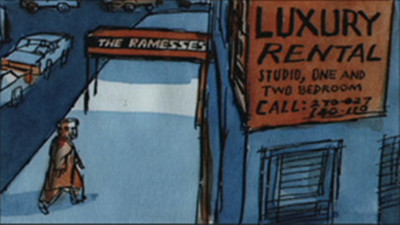The few surfaces not covered by signs are often clad in a distinctive, dark green-gray, striated aluminum siding.
這僅存的沒有被商標遮蓋的建筑,一般都被包裹在有特色的陰暗鋁灰條紋的鋁制外壁板之中。
Take-out sandwich shops,
比如三明治快餐小店,
film processing drop-offs,
賣劣質影碟的小販,
peep-shows and necktie stores.
賣西洋鏡和領帶的小買賣。
Now these provisional structures have,in some cases,remained standing for the better part of a human lifetime.
現在這些臨時的建筑,在一些地方仍然屹立不倒,展現著人們生活另一種美好的時光。
The temporary building is a triumph of modern industrial organization,a healthy sublimation of the urge to build,
這些暫住“居民” 也是現代工業化中的勝利者。它們也是對建樓欲望的一種升華。
and proof that not every architectural idea need be set in stone.
還向人們證明了,不是每一個建筑都是一成不變、無法更改的。
That's the end.
這個故事也講完了。
And the next story is called, "On the Human Lap."
下一個故事叫做:《在人類的膝蓋上》
For the ancient Egyptians the lap was a platform upon which to place the earthly possessions of the dead,30 cubits from foot to knee.
對于古代埃及人來說膝蓋是一個平臺,用來放置死去的人生前塵世的財產。這個平臺的長度就是從腳到膝蓋上。
It was not until the 14th century that an Italian painter recognized the lap as a Grecian temple,
直到14世紀一位意大利畫家第一次把這種膝蓋上的平臺視為古希臘人的神廟,
upholstered in flesh and cloth.
只不過這座神廟是用肉體和衣服布置起來的。
Over the next 200 years we see the infant Christ go from a sitting to a standing position on the Virgin's lap,
在之后的200年里,我們看到嬰兒基督在圣母的膝蓋上,從坐姿變成站姿。
and then back again.
然后又回到坐姿。
Every child recapitulates this ascension,
每一個孩子都是如此,
straddling one or both legs,
跨立在一條或兩條腿上,
sitting sideways,
或者傾斜地坐著,
or leaning against the body.
又或者倚著上身。












